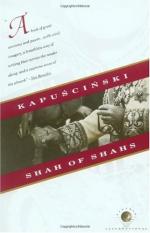|
This section contains 601 words (approx. 2 pages at 400 words per page) |

|
The Dead Flame, pages 101 to 115 Summary and Analysis
Kapuscinski believes the usually reasons for revolution—poverty, oppression, abuses—are not truly the cause for revolution, at least the Iranian revolution. Revolution is caused by the uncontrolled word, and the realm of ideas is the most dangerous for the dictator.
Revolution is spontaneous, a drama. It is so rare because humans avoid that which is uncomfortable, until they have no other choice. The people must be badgered to the point of exhaustion to commence a revolution.
There are two types of revolutions: revolution by assault, and revolution by siege. Revolution by assault seeks immediate violent remedy for perceived wrongs. There is a sudden action and then events calm down. By contrast, revolution by siege starts with small events and few people, but builds into a great crescendo. Revolutions by siege...
(read more from the The Dead Flame, pages 101 to 115 Summary)
|
This section contains 601 words (approx. 2 pages at 400 words per page) |

|




